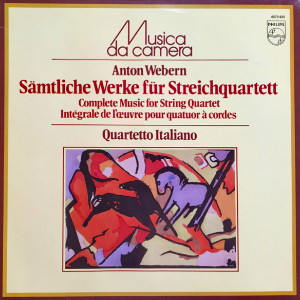 |
|
Philips
- 1 LP - 6570 925
|
|
QUARTETTO ITALIANO
- Paolo Borciani, Elisa Pegreffi, violino
- Piero Farulli,
viola
- Franco Rossi, violoncello |
|
|
|
|
|
Luogo e data
di registrazione |
|
La
Salle des
Remparts, La
Tour-de-Peilz
(Svizzera) -
13-24 giugno 1970
|
|
|
Registrazione: live
/ studio |
|
studio |
|
|
Producer / Engineer |
|
Vittorio Negri |
Tony Buczynski |
|
|
Edizione LP |
|
Philips | 6570
925 | 1 LP |
|
|
Prima Edizione CD |
|
Vedi link alla prima
edizione in long playing.
|
|
|
Note |
|
La
collana
"Musica da
Camera" della
Philips
riedita negli
anni
'80
alcune
registrazioni
del Quartetto
Italiano. |
|
|
|
|
In
Anton Webern's
most mature
music, the new
resource of
12-note
technique and
the
centuries-old
device of
canon come
together in a
musical
language of
unsurpassed
concentration.
That this
synthesis was
not achieved
at once could
be seen from
the foreign
stylistic
elements in
the earlier
works published
during
Webern's
lifetime. But
in the 1960's,
the long
process of
purification
that had
predated even
Opus 1
became still
more evident
with the
discovery of a
collection of
unpublished
manuscripts,
which doubled
the available
corpus of
Webern's
music. The
Slow Movement
and the String
Quartet
contained on
the first side
of this record
both date from
1905 (three
years before
Op. 1), and
they are a
very different
kind of Webern
from the
exquisitely
polished
brevity and
concentration
of the later
music.
The
Slow Movement
is the more
traditional in
style and
layout. Its
idiom is
strongly
tonal, moving
from C minor
to the
relative major
key,
E flat.
Already the
fondness for
the device of
inversion
prefigures his
coming
preoccupation
with
contrapuntal
methods of
organisation.
The String
Quartet (1905)
is headed by a
quotation from
Jacobus Boehme
(1575-1624)
which may be
translated:
"The sense of
triumph that
prevailed
within my
spirit I
cannot write
nor tell, it
can be
compared with
nothing but
the birth of
life in the
midst of death
- the
resurrection
of the dead.
In this light
did my mind
immediately
see through
all things,
and in all
living
creatures,
even in weeds
and grass, did
recognise God,
who He may be
and how He may
be and what
His will is."
The sens of
these words is
reflected in
the mysterious
character of
the opening
measures,
which
eimmediately
present the
basic
three-note
motif from
which the
whole work
grows to its E
major
conclusion.
The music is
continuous,
but it is
built out of
many short
sections,
including at
one point a
slow fugue
lasting only
22 bars.
The
Five
Movements, Op.
5, composed in
1909, show
this tendency
towards
cellular
construction
in a more
advanced
phase. Here
each motif is
developed as
soon as it is
stated.
Tonality is
left behind,
and the
organising
factor is the
complex
application of
contrapuntal
devices. The
brevity to
which such
methods
naturally tend
reaches its
ectreme
manifestation
in the Six
Bagatelles,
Op. 9 of 1913,
whose total
duration is
less than five
minutes.
"Consider what
moderation is
required to
express onself
so briefly,"
said
Schoenberg in
a preface to
the score:
"You cam
stretch every
glance out
into a poem,
every sigh
into a novel.
But to express
a novel in a
single
gesture, a joy
in a breath -
such
concentration
can only be
present
in
proportion to
the absence of
self-pity."
In
the String
Quartet, Op.
28, dedicated
to Elizabeth
Sprague
Coolidge, the
purification
of means is
completed.
Emphasis on
colour is
replaced by
concentration
on line. Where
the earlier
works
frequently
indulge in special
instrumental
effects, in
Op. 28 normal
"arco" and
normal
"pizzicato"
are the two
playing modes,
diversified
only by use of
mytes and by a
single bar on
the bridge in
the second
violin part.
Written in
1938 - 14
years after
Webern had
fist adopted
the 12-note
technique -
the quartet
exemplifies
his own mature
version od
dodecaphonic
method at its
most rigorous
and economical.
Bernard
Jacobson
|
| Illustration:
Franz Marc (1880-1916) "Pferde"
(Hamburger Kunsthalle, Hamburg)
|
|